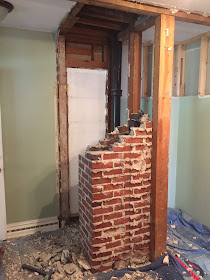First, I had to make a brand new opening in the wall to connect the kitchen to the living room. This was necessitated by the fact that I would be closing off the opening from the kitchen to the hallway to make a brand new pantry. This isn't the best picture to show, but the opening on the right hand side of the photograph is where the new pantry is going to go. That opening lead to the hallway and bedrooms and one could also go from the hallway into the living room. By closing off the kitchen-hallway entrance, I would need a new opening from the kitchen to the living room.
The first thing to do was to cut through the plaster and remove all of the wall, slightly larger than the new 3' opening. To cut the plaster in somewhat straight lines, I used a sawzall with a concrete cutting blade. It worked fairly well.
Above is the new opening from kitchen to living room. On the left you can see the opening to the hallway which will become the new pantry.
Because this is a load bearing wall, I would need to create a new header to bear the load across the new opening. I chose two sandwiched 2'x10's as my header. This is a bit of overkill for a 3' opening, but I already had the wood from the other header I would have to build. The next task was to create a temporary support wall alongside the current wall so that I could remove the studs and install the new header and supports.

Here is the temporary support wall. Now to take out the studs and install the new header. To support the header it would take a king stud on each side and two jack studs under the header on both sides.

Above is the new opening. Following the same process with the bigger opening yielded the results below. With the 8’ door opening I was unable to lift the two sandwiched 2’x10’s on my own. I was supposed to have help from a colleague but a last minute trip meant that he was unavailable. I had to un-sandwich the 2’x10’s and put them in place one at a time and then screw them together. In the end I had one new opening and an 8’ opening instead of the old 4’ opening.



With those openings the demolition was complete and the construction could begin. Come back soon for the construction.













